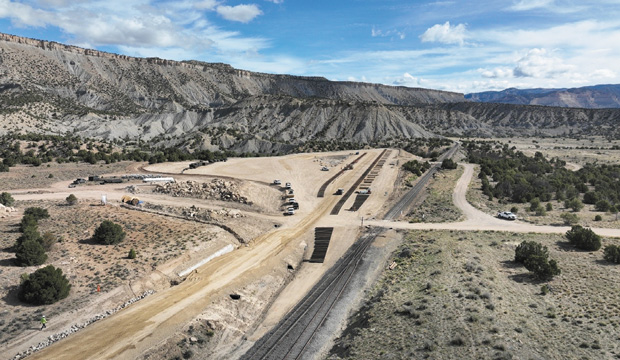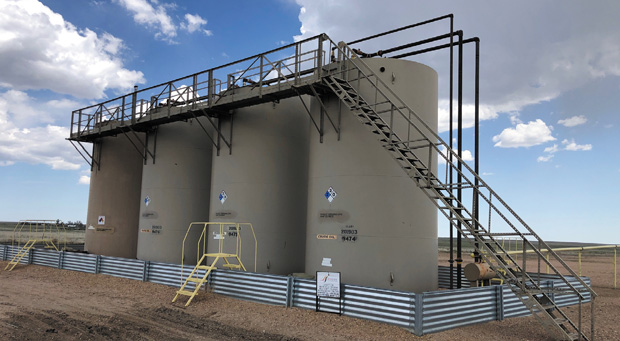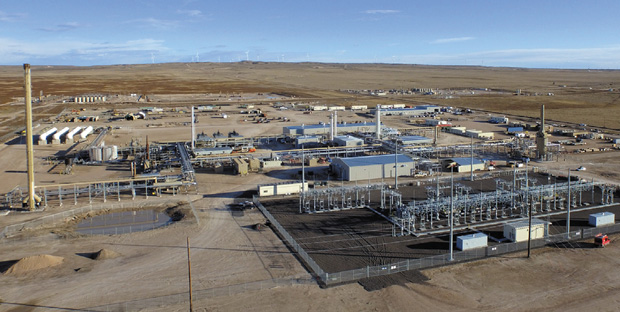
Operators, Midstream Players Pursuing Upside Opportunities In Uinta, Denver-Julesburg Basins
By Danny Boyd
The term “unconventional gas” can be traced back to low-permeability formations on the Western Slope of the Rockies, and the concept of “tight oil” resource plays was proven up in the Bakken-Three Forks in North Dakota. True to its innovative history in developing both oil and gas resources, today operators continue to add new storylines as they pursue crude oil as well as natural gas-focused opportunities across the region, including in the Uinta and Denver-Julesburg basins.
The Uinta is a textbook example of the upside opportunities. The basin produces a waxy crude that is highly attractive to refiners transforming it into high-end lubricants, diesel and jet fuel. Twenty years ago, oil output averaged only about 20,000 barrels a day. However, with the adoption of horizontal drilling and hydraulic fracturing technologies, Uinta oil production has started trending toward historic highs. Some forecasts estimate that daily volumes could eclipse 250,000 barrels a day within the next few years, and with much of that oil shipped by rail to the Gulf Coast, rail transloading facilities are expanding in anticipation of winning more business.
Meantime, while rig counts in the D-J remain steady, upstream players are repositioning through acquisitions, divestments and partnerships as they look to develop both oil and liquids-rich gas targets in the Middle Wattenberg, Niobrara benches and Codell. The D-J midstream sector is also repositioning to better serve basin operators.
First Operated Pad
In late summer, “black wax” crude oil producer Berry Corp. was completing its first operated pad in the Uinta Basin, where it holds 100,000 net acres, mostly in Utah’s Duchesne County. The pad includes four three-mile wells tapping the oil-rich Uteland Butte, reports Chief Executive Officer Fernando Araujo.
Early indicators were very favorable, pointing to cost savings and comparable output to non-operated pads and offset projects, he says. “Our horizontal delineation program is progressing in Utah, and we expect to unlock upside across our position.”
Berry Corp. is completing its first operated pad in the Uinta Basin in Utah, where it holds 100,000 net acres. The pad includes four three-mile wells drilled to the oil-rich Uteland Butte formation. In all, Berry pumped 255 stages with 600,000 pounds of sand and 13,000 barrels of water per stage.
According to Araujo, the Dallas-based company stimulated 255 stages with 600,000 pounds of sand and 13,000 barrels of water per stage. Sizeable cost savings of $500,000 per well came from the use of dual-fuel rigs and frac fleets and 50% utilization of produced water. Wells averaged $680/lateral foot.
“For a first-time operator drilling three-mile laterals, we are really encouraged with the achievement of being 20% below the cost compared to the six non-operated wells that we have and also compared to some of the other operators in the basin,” Araujo remarks. “I think there is still room to improve on that.”
Berry acquired Uinta assets from Williams Companies in 2003 and did a bolt-on of Antelope Creek in 2022. The company holds most of its acreage with 1,200 vertical wells from an earlier development program that drilled in five zones. The assets give Berry extensive data for technical analysis of the basin’s geology.
Neighbors to the north and east are tapping five reservoirs horizontally, including drilling into the Uteland Butte and Wasatch. A Berry non-operated well planned for the fourth quarter will test the Castle Peak, a combination of limestone and sandstone. The sandstone gets thicker as the play extends southward, giving Berry the potential for a thicker Castle Peak on its acreage, he explains.
A significant industry ramp-up in Uinta horizontal drilling over the last two years, coupled with $4.6 billion of industry transaction value in 2024, is driving Berry’s efforts to develop its operated assets after experiencing strong results from non-operated pads, Araujo says.
Non-operated farm-ins have exceeded pre-drill estimates with estimated ultimate recoveries ranging from 55 to 60 barrels per lateral foot. The first non-operated horizontal Uteland Butte well performed at or above projected pre-drill rates, Araujo relates. Peak rates on each of two wells in a second farm-in averaged 1,950 boe/d.
With anticipated success ahead, Araujo says the door is wide open to Berry for the longer-term potential of cube development tapping multiple benches at the same time on the same pad.
Reinforcing operations are a Berry-owned gathering system and gas processing plant and compression system that can be used for gas lifting the wells, Araujo says. The company’s crude production is transported by truck under short-term contracts to several Salt Lake City refineries and by rail to Gulf Coast plants.
Uinta Rail Terminal
Ample rail transloading capacity is crucial to accommodate anticipated growth in Uinta oil production, says Jim Finley, chief executive officer of Fort Worth-based Finley Resources, which owns a majority of Utah rail terminal operator Wildcat Midstream.
Expansions have boosted takeaway at the Wildcat terminal near Helper, Ut., converted to an oil facility after a 2018 acquisition of the Wildcat coal loading terminal from Los Angeles Power & Water, he recalls.
After converting a former coal loading facility near Helper, Ut., into the Wildcat oil rail terminal, Wildcat Midstream can ship up to 100,000 bbl/d from the terminal, with the capacity to expand by another 40,000 bbl/d. Wildcat Midstream ships mostly “yellow” crude, which makes up the bulk of the Uinta Basin’s highly paraffinic, medium-to-high API gravity output.
With the recent expansions, the Wildcat terminal and nearby company facilities can ship up to 100,000 bbl/d. Under a permit from the U.S. Bureau of Land Management, capacity of 40,000 bbl/d could be added on federal land as demand warrants, Finley says. The main rail competitor is Energy Transfer’s Price River Terminal down the road at Wellington.
“If there is 60,000 barrels a day of new Uinta production coming on over the next couple of years, we already have the capacity in our pocket, including our ability to expand,” Finley remarks. “It is obviously a free market and everybody will compete for that additional business.”
Finley Resources entered the basin in 2008 as a producer. In 2019, the company and partner CH4 Energy bought Crescent Point Energy’s Uinta assets. The partners changed the name of Utah production operations to Uinta Wax, which today is managed by CH4, backed by NGP Energy Capital.
About 16,000 bbl/d of Uinta oil production is shipped to Wyoming for blending and transportation to Cushing, Ok., via the Pony Express Pipeline, Finley estimates. The rest is trucked to Salt Lake City refineries or shipped by rail to the Gulf Coast.
Wildcat Midstream ships mostly “yellow” crude, which makes up the bulk of Uinta oil production, Finley details. Uinta oil’s medium-to-high API gravity and low levels of sulfur, acids, metals, and nitrogen make it attractive to refiners. Although not classified as heavy crude, its high paraffin content causes the oil to crystallize into wax at relatively high temperatures, prohibiting pipeline shipment without mixing, he explains.
Black crude solidifies into wax at 105 degrees Fahrenheit, and yellow crude produced from deeper depths crystalizes at 120 degrees, Finley says. At the lease, the crude is stored in tanks heated to 170 degrees. Wildcat contracts with eight trucking vendors that use insulated tank trailers to transport up to 130 loads a day from leases to its rail terminals.
Crude is offloaded into 1,450 Wildcat-owned, insulated railcars at about 150 degrees. The waxy crude solidifies during the five to six-day trip to the Gulf Coast, he explains. By pumping steam through coils on the rail cars, the oil is re-liquified at the refineries.
D-J Partnerships
Publicly held PEDEVCO Corp. operates approximately 19,500 acres in Colorado and Wyoming and is making major moves to boost D-J Basin development through partnerships with bigger private players, says President and Chief Executive Officer J. Douglas Schick. The Houston-headquartered company is focusing on work in Colorado, where larger partner companies with bigger staffs can better navigate the state’s regulatory challenges and simultaneously develop multiple drilling spacing units.
“For us to bring out a rig and completion crew for one drilling spacing unit (DSU) a year is highly inefficient compared to partnering with someone else who is running a rig and completion crew full time, therefore, realizing significant cost savings and synergies. We prefer taking up to a 40-50% working interest and letting them do the work,” Schick says.
In Colorado, PEDEVCO Corp. is partnering with other operators to efficiently develop multiple drilling spacing units. Under a joint development agreement with a large private equity-backed company, PEDEVCO will drill and complete four horizontals, including one U-shaped lateral, in the Niobrara B on the Roth DSU in Weld County by the end of the year. In collaboration with another large private player, drilling is expected to get underway later this year as part of a five year agreement to drill at least five wells annually on a combined 10,750 net acres.
By the end of the year, four new horizontals, including one U-shaped lateral, will be drilled and completed in the Niobrara B on the Roth DSU in Weld County under a joint development agreement with a large private equity-backed company.
In exchange for $1.7 million, PEDEVCO transferred operatorship and reduced its Roth working interest from 70% to 44%. The new operator can acquire up to 50% of PEDEVCO’s holdings in the nearby Amber DSU, giving each company up to a 45% working interest. The partner has already increased the size of each DSU from 1,280 to 1,600 acres to accommodate longer laterals.
In collaboration with another large private player, drilling is expected to get underway later this year, Schick reports. The arrangement incorporates 10,750 net acres held by the two companies with 70% ownership for the private operator and 30% for PEDEVCO, he details. At least five wells will be drilled annually over five years, although up to 18 could be spudded yearly.
The players expect strong well results, he says. Recent offsets near joint positions and PEDEVCO’s own developments include 30-day IPs ranging from 600 to 1,000 boe/d and cumulative production per well averages of 200,000 boe in the first year after completions using over 2,000 pounds of proppant in each foot of lateral.
PEDEVCO formed in February 2011 to acquire and develop D-J assets and eventually added Continental Resources’ properties in the basin. After the 2014-15 downturn forced a drilling stoppage, a new management team led by Schick and a partner acquired a controlling interest in 2018.
However, stricter state regulation authorized by Colorado’s SB 181 soon influenced the team to focus instead on developing a 14,000-acre San Andres position in the New Mexico Permian. Then came COVID-19.
With complications subsiding, in 2021 PEDEVCO began adding D-J acreage. Today, about 14,600 acres are in Colorado and the rest across the state line in Laramie County, Wy. The company began ramping drilling in 2022 and has continued to secure permits, according to Schick.
In addition to recently divesting of non-core, low-working interest wells, the company continues to aggressively look for leasing opportunities in the D-J, where permitted Colorado acreage can go for $6,000 an acre and non-permitted for $300-$1,000 per acre, he notes.
Midstream Expansion
Backed by a corporate strategy of building scale through strategic bolt-ons in key basins, Summit Midstream is expanding in the D-J to better service operators, says Daniel Seaver, vice president of commercial development for the Houston-based company.
With other operations in the Williston, Fort Worth, Piceance and Arkoma basins, Summit has completed three D-J acquisitions over the past three years with a focus on gathering and plants that process associated gas in oily areas. The latest this year was Moonrise Midstream and its operations in Weld County, following Summit’s acquisitions of the midstream assets of Outrigger Energy and Sterling Energy in 2022.
Earlier this year, Summit Midstream closed on an acquisition of Moonrise Midstream facilities in Weld County, Co. That deal followed Summit’s 2022 acquisitions of midstream assets of Outrigger Midstream and Sterling Energy. Focusing on assets that gather and process associated gas in oily areas in the D-J Basin, the Moonrise acquisition adds 65 MMcf/d in processing capacity with the potential to expand to 100 MMcf/d.
Integration over the past two years has resulted in better field pressures and recoveries and more reliability, Seaver says. “We are definitely treating the D-J as a core asset. We like it, and we like that valuations have not gotten to the level of those for the Midland and Delaware basins or the Eagle Ford,” he comments. “We can still remain very accretive to an investor base for a company our size. There is a handful of other opportunities that we really like, and hopefully we will see a couple of them come to market.”
The company transports 20,000 bbl/d of crude in the D-J and acquired a freshwater business through Sterling, but the transactions have transformed Summit into more of a gas gatherer and processor in the basin, Seaver adds.
In addition to gathering and compression assets, the Moonrise purchase from Fundare Resources Company Holdco came with 65 million cubic feet a day of processing capacity expandable to 100 MMcf/d with a modest capital investment, he remarks.
Seaver says the purchase adds redundancy and flow assurance and is supported by long-term, fee-based contracts. Throughput is backed by acreage dedications in oily areas from Fundare, Verdad, Bison IV and a large public company. Residue gas is transported to the Rockies Express Pipeline, liquids to Overland Pass Pipeline, and crude to Pony Express. This adds to the already existing robust downstream options, via Cheyenne Plains, CIG on residue gas and White Cliffs on NGL volumes.
Summit entered the D-J in 2013 with the acquisition of midstream player, Bear Tracker Energy. Assets included the Hereford gas plant located in Weld County near EOG Resources’ Jake No. 2-01H, credited for reopening the Niobrara oil play.
According to Seaver, the company’s gas processing is about 50% utilized right now but can be boosted quickly to about 300 MMcf/d with more development expected to soon follow behind the system as upstream companies launch expected multiyear development plans in 2026.
For other great articles about exploration, drilling, completions and production, subscribe to The American Oil & Gas Reporter and bookmark www.aogr.com.










